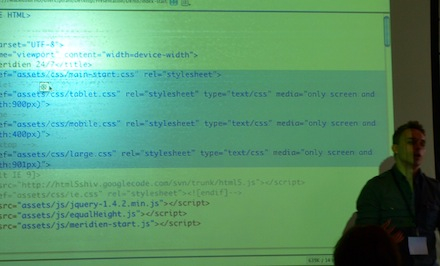I was in NYC on Wednesday, attending part of DevCon5, a two-day conference devoted to the magical HTML5 browser standard.
As I was staring at a Pac-Man app during ‘The Power of Canvas” session— actually the largest Pac-Man mazes in the world crafted completely in HTML5— my mind wandered back to the 1980s.
You know that time when people went to special arcades to play videos games, like Pac-Man, and returned home to get the news or watch a movie on their TV sets.
If you wanted an interactive graphical experience, you essentially rented time on an appliance that connected together cathode ray tube, CPU, and memory.
Back to the present.
At the HTML5 sessions I sat in on, I saw impressive game apps, charting apps, video apps, and just interesting web designs all choreographed by the browser, now truly a magical multi-media appliance.
Like a TV set you turn it on, no need even to load an app from your old fashioned local file system, the browser (with hardware acceleration enabled) automatically performs wondrous feats of animation and graphical processing.
I’m not a developer or web designer, but this former software hacker saw enough of the power and simplicity of HTML5 to get excited by its possibilities.
No, I’m not taking on a game app, but I might jazz up the rusty Flash code I use for slideshows using Radi, or add charts to my dry text with Piety—see Tommy Lewis’s blog below for more HTML5 tools and goodies.
But HTML5 is more than this. With its browser-centric model of development, apps are no longer imprisoned on a specific hardware or operating system island. The browser, not the PC or laptop or iPad, is the platform.

Adobe’s Paul Trani explains CSS3.
So what does all this mean?
In his keynote, Charles Jolley, the guy behind Apple’s Mobile Me, pointed out that with HTML5, your development effort switches from the server side to the client device.
It makes sense: if you’re creating an experience that will be delivered on all kinds of gadgets and form factors, then your UI/UX has to be excellent.
JavaScript, which is definitely an afterthought for most web sites (mine included), now gets center stage. Jolley pointed out that latest HTML5-based Twitter web site, has about 500K of JavaScript—kind of astonishing.
By the way, Jolley’s newest venture, Strobe, will help companies manage client-side complexities by providing support for SproutCore, a framework for developing JavasScript apps in this new HTML5 environment.
The key fact that makes HTML5 central to the next phase in computing is the number of mobile devices. Jolley said that last year sales of tablets and smartphones, at about 500 million units, exceeded that of PCs. In the next 5 years, the installed base of these mobile gadgets will top 2 billion units!
I did a quick Google search on the annual sales of LCD TV worldwide: it’s something like 200 million, and there are probably over a billion TVs in people’s homes.
Simply breathtaking how fast mobile gadgets have moved ahead of TV. It’s the number 1 video device, and with HTML5 on board it will become the most important and powerful media appliance ever.
Related articles
- Worlds Biggest Pac-Man
- Thomas Lewis’s A Simple Pixe blogl (tumblr.com)
- CSS3 Guru and Adobe Evangelist Paul Trani’s blog (paultrani.com)
- 30 Must See HTML5 Tutorials (spyrestudios.com)
- Strobe


